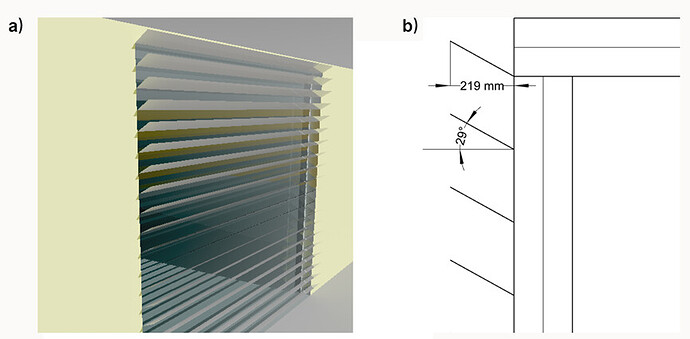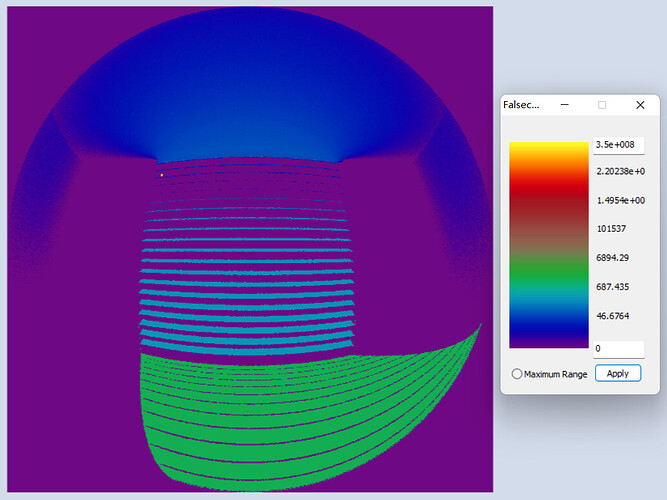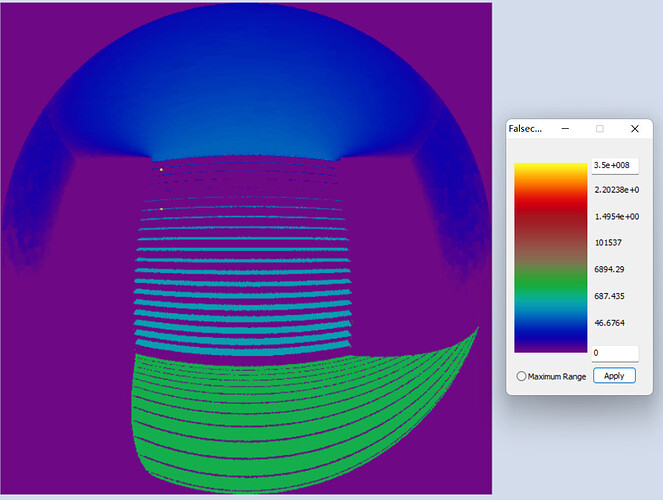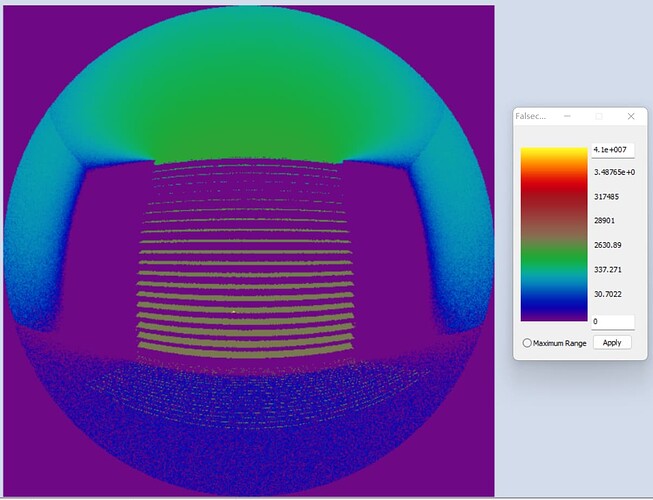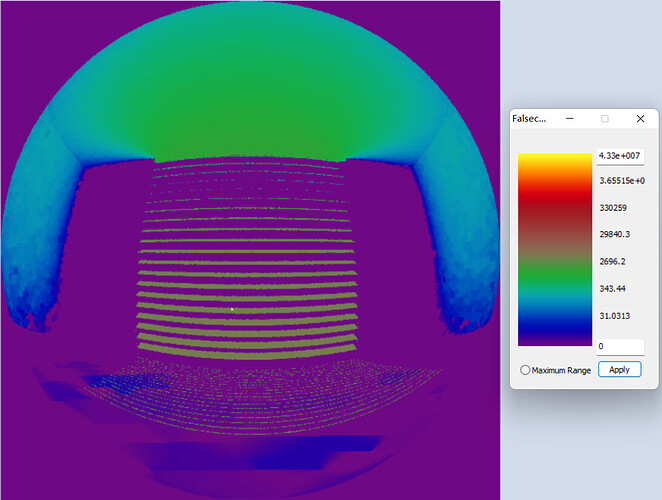I’m modeling a building with a specular blinds (Fig.1) located in Shanghai, when I compared results derived from 5-phase with those derived from conventional raytrcing method, I found sometimes decrepency between both methods were very large beacause sometimes specular reflection cannot be captured by sun-coefficient simulation. Comparison results are shown as Fig.2 and Fig.3.
Fig.1 blinds
Fig.2 Luminance map obtained by sun-coefficient method (1/1 10:00 am)
Fig.3 Luminance map obtained by rpict ((1/1 10:00 am))
Below two figures (Fig.2 and Fig.3) showed that two high-intensity points presented in luminance map simulated by rpict, but only one high-intensity point presented in luminance map simulated by sun-coefficient.
The point on top is solar and the lower point is the specular reflection light in Fig.2, but the specular reflection light absented in Fig. 3.
Somtimes both methods can capture specular reflection light, as shown below:
Fig.4 Luminance map obtained by sun-coefficient method (12/22 15:00 pm)
Fig.5 Luminance map obtained by rpict (12/22 15:00 pm)
My commands:
sun-coefficient:
echo “void light solar 0 0 3 1e6 1e6 1e6” > suns.rad
cnt 5185 | rcalc -e MF:6 -f reinsrc.cal -e Rbin=recno -o ‘solar source sun 0 0 4 ${Dx} ${Dy} ${Dz} 0.533’ >> suns.rad
oconv -f mat-black.rad 5pmmodel.rad suns.rad blinds.rad > sunCoefficients.oct
vwrays -vf Views/view.vf -x 600 -y 600 -pj 0.7 -ff | rcontrib -w- -i -ab 1 -ad 256 -lw 1.0e-3 -dc 1 -dt 0 -dj 0 -ffc -n 16 vwrays -vf Views/view.vf -x 600 -y 600 -d -o matrices/cds/hdrIllSpace/viewM6%04d.hdr -e MF:6 -f reinhart.cal -b rbin -bn Nrbins -m solar sunCoefficients.oct
oconv -f mat.rad 5pmmodel.rad glazeVmtx_black.rad > materialMap5Phase.oct
rpict -x 600 -y 600 -ps 1 -av 0.31831 0.31831 0.31831 -ab 0 -vf Views/view.vf materialMap5Phase.oct > matrices/cds/materialMapview.hdr
vwrays -vf Views/view.vf -x 600 -y 600 -pj 0.7 -ff | rcontrib -w- -ab 1 -ad 256 -lw 1.0e-3 -dc 1 -dt 0 -dj 0 -ffc -n 16 vwrays -vf Views/view.vf -x 600 -y 600 -d -o matrices/cds/hdrLumFacadefeye/viewM6%04d.hdr -e MF:6 -f reinhart.cal -b rbin -bn Nrbins -m solar sunCoefficients.oct
for idx in {0000…5185}
do
pcomb -h -e ‘ro=ri(1)*ri(2)+ri(3);go=gi(1)*gi(2)+gi(3);bo=bi(1)*bi(2)+bi(3)’ -o matrices/cds/materialMapview.hdr -o matrices/cds/hdrIllSpacefeye/viewM6${idx}.hdr -o matrices/cds/hdrLumFacadefeye/viewM6${idx}.hdr > matrices/cds/hdr/view${idx}.hdr
done
gendaymtx -5 0.533 -d -m 6 shanghai.wea > shanghai5PM.smx
dctimestep -o results/5ph/cds/hdr/view%04d.hdr matrices/cds/hdr/view%04d.hdr shanghai5PM.smx
Conventional ray-tracing:
gendaylit 1 1 9.500 -a 31.40 -o -121.45 -m -120 -W 293 0 -O 0 > sky10.rad
oconv -f sky10.rad mat-black.rad 5pmmodel.rad blinds.rad > model.oct
rpict -i -lw 1e-5 -ps 1 -ab 1 -ad 1000 -lw 1e-5 -dc 1 -dt 0 -dj 0 -x 600 -y 600 -vf Views/view.vf model.oct > face.hdr
rpict -lw 1e-5 -ps 1 -ab 1 -ad 1000 -lw 1e-5 -dc 1 -dt 0 -dj 0 -x 600 -y 600 -vf Views/view.vf model.oct > win.hdr
oconv mat.rad 5pmmodel.rad glazeVmtx_black.rad > mm.oct
rpict -vf Views/view.vf -ps 1 -x 600 -y 600 -av 0.31831 0.31831 0.31831 -ab 0 mm.oct > MM.hdr
pcomb -h -e “ro=ri(1)*ri(2)+ri(3);go=gi(1)*gi(2)+gi(3);bo=bi(1)*bi(2)+bi(3)” -o MM.hdr -o face.hdr -o win.hdr > 10.hdr
